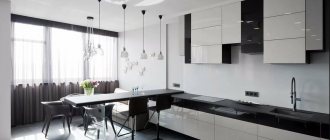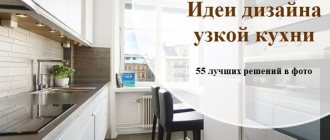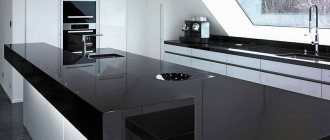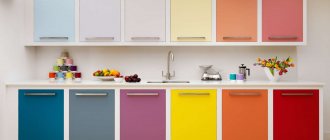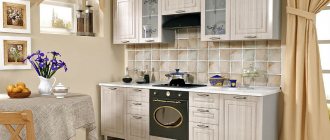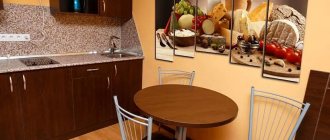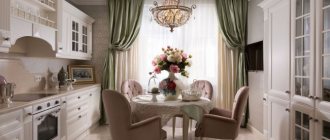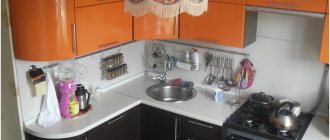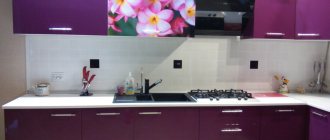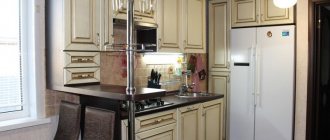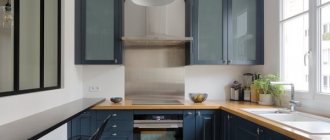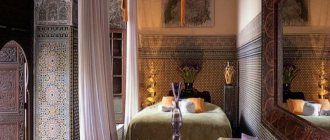Quite a lot of people like the cozy, but at the same time laconic Mediterranean style. It is one of the varieties of the popular Provence style, but it has a number of its own distinctive features, which allows it to be placed in a separate category. The Mediterranean style has absorbed the traditions of several countries at once - France, Italy, Spain, Greece.
Mediterranean style kitchens look very cozy and stylish.
Thus, the freedom of design imagination becomes much wider, and the possibilities for designing a kitchen appear many times more. In this article we will take a detailed look at all the features of the Mediterranean style and give tips on how to make your kitchen truly cozy and beautiful.
The style is very liberal, but it is still worth following the rules.
General design trends
Like any other style, Mediterranean has its own traditions, which should be strictly adhered to. However, it is much freer than the classical types of design, for many of which the rules are unshakable - here you can allow various variations.
Mediterranean-style kitchens can be very diverse.
Let's take a closer look at what features are inherent in the Mediterranean style:
- Most Mediterranean countries adhere to laconicism in the interior. Therefore, you will have to abandon complex, overly elaborate materials and furniture. Give preference to simple lines and textures - with the right combination, they look much more advantageous than complex ones.
- You can compensate for the simplicity with a rich color palette: you are free to use almost any natural shades found in nature and combine them in any way you like. We will tell you more about the colors of a Mediterranean-style kitchen below.
- Finishing materials must be natural or qualitatively imitate natural ones: stone, wood, fabrics, leather, metals. Avoid plastic and lots of glass - they are not typical for the Mediterranean style.
- Remember that the main principle is the combination of beauty with practicality. This means that in such a kitchen there is no place for various decorations that simply take up space: any decor should also have a practical function.
As you can see, nothing is complicated: such rules leave a huge scope for imagination. Now let's move on to more specific recommendations.
The main thing is to find those features that appeal to you.
Italian style direction
The Italian Mediterranean is characterized by very warm colors. The interior uses orange, light brown tones, and shades of green.
These are the colors used to paint plastered wall surfaces.
Coffee makers and coffee machines: modern equipment for business, home and office- What to consider when buying a coffee machine
Ventilation grilles
To cover the floor space, natural wood sheets, a bleached plank surface or tiles decorated with ornate prints are laid.
Working with the floor
As we have already said, materials are of great importance - they should be predominantly natural. Most often, tiles or porcelain stoneware are used to finish the floor in the kitchen - they are hygienic, durable and not too expensive.
Sometimes a combined solution is allowed for different zones.
In addition, warm-colored marble is suitable. If a real marble floor seems too expensive for you, you can try to find a suitable imitation. However, the latter must be of high quality - this style does not tolerate outright fakes.
The floor is simply a backdrop to the kitchen, but that doesn’t mean it should be neglected.
Advice! Marble mosaic tiles on the floor are a real boon for a Mediterranean-style kitchen. However, remember that it should not be too pretentious.
A wooden floor also looks good. Choose warm, not too dark shades - the latter may look too heavy.
There are many options for floor design.
The most budget-friendly options can be considered laminate or linoleum - if you choose the right texture, the floor will fit into the interior of your kitchen.
By the way! Warm floors are the ideal solution for a Mediterranean-style kitchen. It will make it much warmer and more comfortable, which is quite consistent with the concept.
A few touches for Mediterranean style: functional decor
Curtains and textiles. The Mediterranean climate determined the extremely small use of textiles for window decoration. Therefore, the design of such a kitchen involves the installation of shutters or wooden grilles, if we talk about our own cottage. For an apartment, the optimal solution would be natural curtains made of linen or cotton. You can embroider an ornament on them with your own hands to match the apron and other textile elements in the kitchen. Despite the lack of decor in the literal sense, it becomes parts that carry a functional load. These include pillows on chairs, blankets on the sofa, and napkins.
Crockery and utensils. Such parts are placed on open shelves and hung above the island of the work area, which already decorates the kitchen. The design of the utensils is therefore also of considerable importance. Ceramic plates and cups, cast iron frying pans, cauldrons, and copper pans are used here, which are always in plain sight, as can be seen in the photo.
Lamps. Forged candelabra and imitation antique lanterns will become a real decoration of Mediterranean cuisine. But due to their high cost, you can use a photo with them on one of the walls, simulating the view from the window, and then indoors you should use lamps whose lampshades can be stylized: choose textile parts with a suitable ornament or the desired shape. You can choose a suitable lamp design in the form of a metal mesh, imitation of natural wood or stone elements.
When choosing decor for such a kitchen, evaluate the functionality of the details. There should be no excess in a Mediterranean interior, because it takes up space and brings completely different notes to the interior. And the warm and cozy style of the Mediterranean is different in that it is decorative in its simplicity.
Ceiling finishing
The ceiling occupies a special place in this style. Most often it is decorated with wooden beams - simple or decorative. Think carefully about whether this solution is suitable for your kitchen - in rooms with low walls, the beams will look too heavy, which means they will simply kill it visually.
Ceiling beams look beautiful, but are not suitable for every kitchen.
However: It is not necessary to make the beams massive. Simple thin wooden slats are enough to create an atmosphere. This technique can be used even in the smallest kitchens.
Use plaster as a base - simple or decorative. It is very important to achieve a smooth, evenly painted surface - the appearance of the ceiling largely depends on this. Give preference to light, pastel shades.
Small dark accents are allowed, but the base should be light.
Wall decoration in the kitchen
If the ceiling should be perfectly flat, the walls, on the contrary, should be made rough and textured. This combination will make your kitchen interesting and attractive, filling it with comfort.
However, a lot depends on which direction of the Mediterranean style you prefer. For example, relief in the Greek version is achieved through the choice of finishing materials - liquid wallpaper, plaster, paint. In this case, it is important to choose the right type of coating - for example, textured decorative bark beetle plaster or curly panels.
It is important to pay attention to the topography of the kitchen.
For Italian and Spanish styles, the use of a combination of different types of materials is closer. For example, plasters with wallpaper or wood panels. You can safely combine even three or four types of coating - the Mediterranean style allows such experiments. However, the transition should be smooth - different materials that are similar in tone look best.
Don’t be afraid to combine materials of different colors and textures.
Tip 3. We give preference to natural finishing materials or high-quality imitations
- For wall decoration, it is preferable to use: decorative plaster, brickwork (or very high-quality imitation), textured plain wallpaper or paintable wallpaper. Walls in the Greek style are most often white, in Spanish - beige, olive, orange, etc.
- In floor finishing: porcelain tiles imitating stone, for example, travertine, ceramic tiles also imitating stone or unpainted clay, as well as wooden parquet boards, natural wood, laminate.
Adviсe:
- It is desirable that the wood on the floor appears bleached and worn;
- Stone, porcelain stoneware and tiles should be insulated with a heating system, because while in hot countries these materials provide pleasant coolness, in northern latitudes they only bring discomfort.
- The following materials are suitable for finishing the ceiling: plaster, matte paint, suspended matte ceiling, ceiling made of wooden lining. For high ceilings, decorative beams as in the photo below are appropriate as an addition.
Apron
The walls, floor and ceiling in such a kitchen are more like edging. The main design role is given to the apron, so it must be finished with all possible care.
The classic choice is a neat mosaic backsplash.
The most traditional option for a backsplash is ceramic tiles or mosaics. Don’t be afraid to use frescoes, tiles, and various ornaments. Unusual color combinations, various patterns - and such an apron will become a real decoration of your kitchen.
However, classic tiles may be appropriate.
However, avoid being too fussy as it can cause damage. It is better to give preference to geometric, floral or ethnic motifs. They will always be appropriate and will not overload your kitchen.
A fashionable technique is the use of specially aged tiles. Scuffs and roughness will add charm to the room. However, remember that simply old materials will not work - the antique effect looks good only if it is achieved on purpose.
Retro tiles are an excellent choice.
Furniture
It is very important to choose the right pieces of furniture - otherwise all efforts to create a characteristic finish may be in vain. For Mediterranean interiors, we recommend choosing massive furniture made of natural wood. However, some elements may be metal. But it is better to avoid glass, plastic and other modern materials - they are not very suitable for this design.
Massive pieces of furniture are a must-have.
will suit you:
- Wooden sideboards with open shelves. The Mediterranean style is characterized by a large amount of open space, so it is better to avoid closed cabinets, at least in the upper part of the set.
- Wicker or forged chairs. Here you can move away from the overall massiveness - against the backdrop of bulky furniture, elegant chairs look very advantageous.
- Massive tables made of wood, round or rectangular.
- A wide variety of shelves on which you can place all the necessary kitchen utensils.
Special attention should be paid to the tabletop. It can be either simply stone or with an unusual mosaic pattern. The last option looks very attractive, but you need to understand that the design of the tabletop should be combined with the apron. Otherwise you'll end up with ridiculous kitsch.
You can smooth out the massiveness with color.
It is better to select household appliances in light colors, but if you wish, you can decorate them at your discretion. Decoupage, painting, various types of designs - all this will decorate your kitchen, making it more comfortable. However, in this case it is extremely important not to overdo it - the patterns should be light and airy.
You need to be careful when fitting appliances into the interior of such a kitchen.
Set
Original furniture made of bleached wood, roughly painted on top, blue or blue paint, forged parts, wicker elements - all this, along with a fair amount of asceticism, symbolizes Greece.
But for Italy and Spain, softer wood processing is closer. Even carving is allowed, but not complicated.
The modern Mediterranean style welcomes such deviations from traditional design as the presence of glass and metal surfaces, as well as chrome and gloss finishes.
Color selection
This type of design welcomes the use of a wide variety of shades of a natural, natural palette - from delicate pastels to rich, catchy ones. There are two types of color schemes.
It is important to find the right color solution.
Monochrome design is typical for Mediterranean-style kitchens, made in the spirit of Spain or Italy. Smooth transitions of tones, warm tones... In this case, it is better to focus on light shades - beige, yellow, soft light green, white, coral. However, no one forbids adding two or three bright shades - for example, blue, burgundy or terracotta. It is better to place strokes of color on the apron or in decorative elements - this way the room will look more organic.
A colorful accent will brighten up your kitchen.
The basis of the contrasting design is white. This design is typical of the Greek style. At the same time, white can harmonize with almost any shade, except, perhaps, glossy metallic and various acid tones. Combine it with blue, red, yellow, green colors - it all depends on your preferences.
Dilute matching shades with accents.
What type of color scheme should I choose? You decide. Both have their fans and opponents. However, let us draw your attention to the fact that monochrome design is more suitable for small spaces - due to the abundance of light colors, it visually makes a small kitchen larger.
Don't be afraid to experiment.
Features of kitchen design in different Mediterranean countries
The Mediterranean Sea borders several countries, facilitating the mixing of cultures. Of course, this is reflected in the design of the space - the interior is reminiscent of the decoration of the local villas.
The Mediterranean style of cuisine is characterized by simplicity, so it becomes a godsend for those who want to escape the bustle of the city and enjoy a slower life. There are several directions of such design, which can be conditionally distinguished based on the sign of territoriality.
Greece
The incredible island of Santorini is remembered by vacationers not only for its warm sea and sandy beach, but also for its unique houses, which are painted white and decorated with blue details. The following tones are most often used to decorate the kitchen here:
- pink or red;
- green, blue or light blue with white;
- lemon, soft yellow or terracotta.
Plaster is used for finishing, and red-brown tiles are used as flooring.
Greek design combines lightness and sophistication
Italy
Unlike the Greek interior, the Italian interior is dominated by warm shades:
- green, including pistachio, olive;
- beige, light brown;
- wheat, golden;
- orange.
To decorate the floor, bleached wood is often chosen, but tiles with patterns also look good.
Spain
Spanish style is suitable for passionate natures who choose picturesque colors for the kitchen interior:
- ocher;
- terracotta;
- dark brown shades;
- yellow and orange tones.
However, the interior color does not play a decisive role here, because the highlight of such a kitchen is the bright inserts, for which the following colors are used:
- blue;
- green;
- black;
- white;
- red.
Important! When creating such a design, it is important to avoid oversaturation of colors. So, you should remember the basic rule: 2 primary colors are combined with 2 additional ones.
The interior of Spanish cuisine should be dominated by no more than 4 tones
Choosing lighting
In the classical sense, a Mediterranean-style kitchen should be filled with light. If during the daytime this is facilitated by natural lighting, then you will have to take care of artificial lighting yourself.
Lighting is an important aspect of a Mediterranean-style kitchen.
First of all, give preference to lamps of the natural light segment - warm shades are much better than modern cold ones, which are not suitable for this type of interior. Plus, they're better for your eyes.
Hang a beautiful small chandelier or sconce above your dining table. It could be a classic lamp, a lamp in Provence or country style, an unusual hand-made lampshade - here your imagination is practically unlimited.
In the work area you can also use various types of sconces or, on the contrary, limit yourself to spotlights. It would not be a bad idea to install lighting on the furniture - for example, along the bottom line of the upper cabinets. This will make your work more comfortable and is fully consistent with the “More Light!” concept.
Layout
The Mediterranean style of cuisine is most often thought out to the smallest detail. A bright and spacious room is chosen for it, since it is intended not only for preparing dishes, but also for family meals. Each type of layout has its own characteristics.
Kitchen-living room
The kitchen-living room is the most preferable option, because you can comfortably place a large amount of furniture on it, without limiting the space of the work area where food is prepared.
When decorating such a part of the room, there can be no question of zoning; it is only permissible to create an island that will separate the working and dining areas. The dining area should definitely have a wicker or wrought-iron sofa with pillows in a light color palette. To highlight the interior decoration, it is necessary to decorate the kitchen-living room with fresh flowers in large flowerpots.
Small kitchen
The Mediterranean style is ideal for large kitchens, but if you only have a small one, then you can create such an interior by borrowing only some of its features. For example, you can decorate your apron with azulejo, majolica or mosaic, but certainly in red-brown color.
The smaller and lighter the tiles, the larger the room will appear.
The set is chosen from wood, and it is desirable that one of the cabinets is always open and resembles a buffet. To visually expand the room, it is recommended to use numerous lamps and hang a chandelier above the dining area.
Don't forget about gender. So it is decorated with glass containers filled with:
- coffee;
- tea;
- seasonings;
- cereals;
- pasta.
A compact small Italian-style kitchen can also be convenient and beautiful
We focus on textiles
The main role in decorating a kitchen in a Mediterranean style lies with textiles. You need to carefully select curtains, tablecloths, napkins and other fabric items needed in the kitchen. In addition, you can sew special covers for chairs or put small cushions on the seats - all this will be quite appropriate.
Even small textile elements will decorate the kitchen.
It is only important that all the elements are combined with each other - perhaps it makes sense to think about making custom textiles.
Kitchen textiles should be made from bleached and unbleached linen, cotton and chintz. All materials must be of the highest quality. As for decoration, you can decorate textiles with patterns, embroidery, ornaments, images with plant or ethnic motifs.
You can replace textiles with rattan - if for some reason you don’t like the fabric.
It would be a good idea to put a couple of small rugs in the kitchen. This is especially true if there are children in the house - it will be much more comfortable for them to be in the kitchen.
A small rug will add coziness to the kitchen.
As for curtains, you should choose light, flowing tulle or give preference to simple cotton curtains. The rules here are the same as for kitchen textiles - high-quality fabrics and unobtrusive patterns in natural colors.
Decorate your kitchen with bright curtains.
If fabric curtains aren't your thing, consider bamboo blinds or roller blinds - they're also fine.
Finishing touches
[ads2] Having decided on the main components of the kitchen interior, you can move on to additional details.
Household appliances should be chosen so that they do not stand out, use built-in models or hide them behind furniture facades.
But this rule does not apply to the hood, since it is given almost the key position in the interior. The hood must stand out, have a dome shape, contribute not only to the everyday improvement of the kitchen space, but also serve a decorative purpose.
For a spacious kitchen you need to purchase a large sink, even a double one will do. An excellent solution is a ceramic sink or an artificial stone model. Copper and bronze are also considered popular materials for kitchen plumbing equipment.
We recommend decorating window openings with light curtains made from simple materials. The color scheme and designs should also be light and airy.
Give preference to light-colored curtains decorated with floral patterns and other uplifting designs. Curtains with a classic style, French and Roman, are welcome.
Read about how to design an ideal kitchen in the neoclassical style: characteristic features, principles of design and decor, ready-made options for kitchen interiors after renovation.
Rules for decorating a high-tech kitchen interior can be found here.
Different models of kitchen sets in country style can be viewed in the gallery at:
Make sure you have good lighting.
In the summer, large window openings will fill the room with natural light. Artificial light sources can be placed in each functional area.
Above the dining table, hang a statement chandelier with a bronze finish and a Tiffany design lampshade.
To illuminate the island, use pendant lamps or ceiling spotlights with directional beams.
Accessories should be selected with taste and a sense of proportion should not be forgotten. A special role is given to presentable kitchen utensils - this makes the Mediterranean style similar to other rustic trends.
Beautiful dishes are placed on the shelves of the kitchen unit and in free niches.
Decorate the kitchen with porcelain containers for spices, copper utensils, place original shaped bottles filled with oil, containers with cereals and dried fruits on the shelves.
Choosing decor
There should not be too much decoration in a Mediterranean-style kitchen. Pay attention to quality, not quantity: all decorative elements should be expensive, durable and, preferably, functional.
The decor should be laconic.
You can use various beautiful dishes, decorative flower pots, and plants. Small flowerpots with spices, miniature peppers or tomatoes look good - both beautiful and tasty.
Everything must fit together.
Hanging bunches of dried herbs or flowers look interesting - if desired, they can also be used in cooking.
We are sure that with our tips you can easily create a beautiful Mediterranean-style kitchen!
[author_bq]
Spanish traditions in Mediterranean design
The Mediterranean style also includes Spanish motifs, gravitating towards a warm natural color. Surfaces are decorated with eco-friendly materials; similar raw materials are used in the manufacture of furniture, as well as decorative elements.
Attention is drawn to motley contrasting color spots against the background of the neutral decoration of the room. The main task is to create an atmosphere of a warm home.
When arranging the interiors of premises with Spanish motifs, domed ceilings, niches with an arched configuration, and stoves resembling fireplaces with original vaults are often designed.
Dark-colored forged decorative elements or furniture components are another distinctive feature of the furnishings, associated with traditional Spanish flavor.
Spanish-style kitchens feature natural wood furnishings, stone countertops and decorative ceramic tiles.
For additional decoration, wrought iron lighting fixtures placed on the walls and ceiling, bar stools reminiscent of garden furniture, and a kitchen island with a stone countertop are used.
In Spanish interiors you can also find elements characteristic of rough country. Raw beams on the ceiling surface are often adjacent to modern kitchen appliances, large pieces of furniture, decorated with carvings and elegant accessories.
Decorating the ceiling with beams is a characteristic feature of the Mediterranean style; in most cases, this is the only rustic detail in a classic southern kitchen setting.
Original ceiling structures become the central element of the design concept.
We looked at the features of Spanish, Italian and Greek design that make up the Mediterranean style separately, and now we will study the common features of the design that Mediterranean residents choose for their homes.
Ways and techniques for decorating a modern kitchen interior in Italian rustic style: finishing and furnishing options, choosing a palette and decorative elements.
For the best nautical kitchen design ideas, check out this article.
